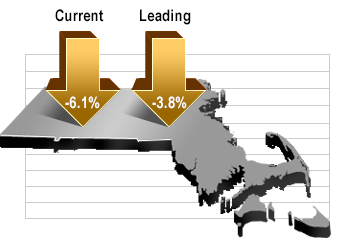Bay State Economy contracts in Q1, UMass Journal reports
Data do not reflect the full impact of COVID-19; Q2 expected to be the worst quarter on record
April 2020
» Download the detailed report
 In the first quarter of 2020, based on the best information available today, MassBenchmarks estimates Massachusetts real gross domestic product (GDP) declined at a 6.1 percent annualized rate while U.S. real gross domestic product declined at a 4.8 percent rate according to data released by the U.S. Bureau of Economic Analysis (BEA) earlier today. In the fourth quarter of 2019, both Massachusetts GDP and U.S. GDP expanded at a 2.1 percent annualized rate.
In the first quarter of 2020, based on the best information available today, MassBenchmarks estimates Massachusetts real gross domestic product (GDP) declined at a 6.1 percent annualized rate while U.S. real gross domestic product declined at a 4.8 percent rate according to data released by the U.S. Bureau of Economic Analysis (BEA) earlier today. In the fourth quarter of 2019, both Massachusetts GDP and U.S. GDP expanded at a 2.1 percent annualized rate.
The Massachusetts and U.S. economies currently are in a recession that began in the second half of March, triggered by the impact of the COVID-19 pandemic. The negative growth rate estimates for the first quarter of this year do not reflect the full severity of the pandemic-induced downturn. This is because the economic indicators used to estimate growth primarily reflect economic activity that preceded the sharp downturn that began in the middle of March. Two key labor market indicators for March — payroll employment and the unemployment rate — reflect conditions between March 8th and March 14th, prior to the shutdown of non-essential businesses that began in Massachusetts on March 24 and before the sharp rise in unemployment claims that began on March 15. Regular state sales tax revenues in March reflect purchases made in February, and first quarter wage and salary income includes what was an apparently strong "bonus season" based on income realized in January and February.
After adding 14,200 jobs in January and February, Massachusetts payroll employment declined by 18,000 in March. In the first quarter, payroll employment in Massachusetts grew an estimated 0.9 percent on an annualized basis as compared to the fourth quarter of 2019. In the fourth quarter of 2019, jobs grew 0.2 percent. For the U.S., first quarter job growth was 1.0 percent, and in the fourth quarter 2019, payroll employment grew by 1.7 percent. Year over year, employment grew 0.6 percent (2019 Q1 - 2020 Q1) in Massachusetts. Nationally, during the same period payroll employment in the U.S. grew 1.3 percent.
The unemployment rate in Massachusetts rose from 2.8 percent in December 2019 to 2.9 percent in March. Nationally, the unemployment rate rose from 3.5 percent in December to 4.4 percent in March. The broader U-6 unemployment rate rose from 5.9 percent in December to 7.9 percent in March, largely because the number of persons working part-time for economic reasons rose by 56,000 between December and March. The national U-6 unemployment rate rose from 6.7 percent in December to 8.7 percent in March.
Wage and salary income in Massachusetts, as estimated from withholding tax revenue, grew at a seasonally adjusted annual rate of 15.5 percent in the first quarter of 2020. Withholding taxes were particularly strong in January and February, likely reflecting a strong bonus season as the S&P 500 stock index grew 24 percent in 2019. In the fourth quarter of 2019, Massachusetts wage and salary income grew 3.6 percent according the BEA. U.S. wage and salary income grew 2.8 percent in the first quarter of 2020 as estimated by MassBenchmarks and 3.8 percent in the fourth quarter of 2019 as estimated by the BEA.
Spending on items subject to the Massachusetts regular sales tax and the motor vehicle sales tax rose 4.4 percent at an annual rate in the first quarter, following 9.0 percent growth in the fourth quarter of last year. Such spending rose 6.3 percent from the first quarter of 2019 to the first quarter of 2020.
The leading index is projecting that the state's economy will contract at a 3.8 percent annual rate between March and September. This vastly understates the magnitude of the decline in the economy that has already occurred between mid-March and today.
"Between March 15 and April 18, 650,000 people filed unemployment claims in Massachusetts," noted Alan Clayton-Matthews, MassBenchmarks Senior Contributing Editor and Associate Professor of Economics and Public Policy at Northeastern University, who compiles and analyzes the Current and Leading Indexes. "This implies that the number of persons unemployed, on layoff or furlough, or who lost their job because of the pandemic accounted for roughly 20 percent of the labor force as of mid-April. Therefore, the actual decline in Massachusetts gross domestic product in the second quarter is expected to be on the order of 25 percent to 50 percent on an annualized basis," Clayton Matthews added.
» Download the detailed report
_________
MassBenchmarks is published by the University of Massachusetts Donahue Institute in cooperation with the Federal Reserve Bank of Boston. The Donahue Institute is the public service, outreach, and economic development unit of the University of Massachusetts Office of the President. The Current and Leading Indexes are compiled and analyzed by Dr. Alan Clayton-Matthews, Associate Professor of Economics and Public Policy at Northeastern University and released quarterly by MassBenchmarks.

